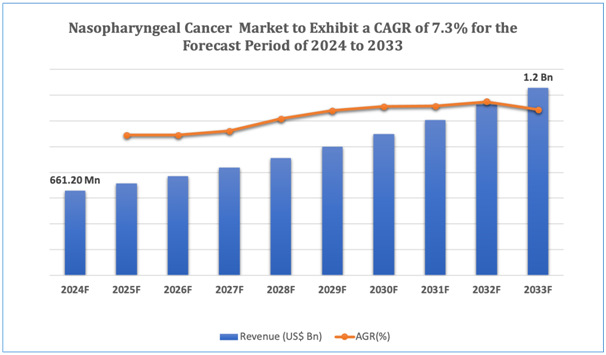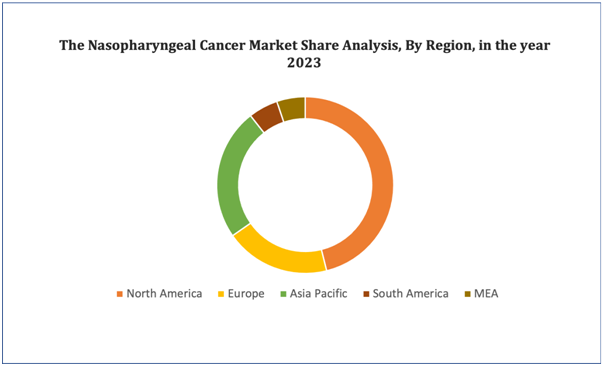Nasopharyngeal Cancer Market Overview
The global Nasopharyngeal Cancer market is estimated to be worth over USD 1.2 Bn in 2033 and is expected to grow at CAGR of 7.3% during the forecast period (2024-2033). Nasopharyngeal cancer (NPC) stands as a rare form of head and neck cancer that arises in the nasopharynx, the upper portion of the throat behind the nose. It is marked by the unusual growth of cells in the lining of the nasopharynx and is oftentimesrelated to the Epstein-Barr virus (EBV) infection, genetic predisposition, and environmental factors such as consumption of preserved foods and exposure to various chemicals. NPC generally presents with symptoms like a persistent nasal congestion, lump in the neck, hearing loss, and blood-tinged saliva. Diagnosis typically involves a confluence of imaging tests, such as MRI and CT scans, in conjunction with biopsy for confirmation. Treatment alternatives for NPC depend on the stage of the cancer and may comprise radiation therapy, chemotherapy, and surgery, often in combination.
The global market for nasopharyngeal cancer treatment surrounds a scale of pharmaceuticals, surgical instruments, radiation therapy equipment, and diagnostic tools emphasized at enhancing patient outcomes and survival rates. Regardless of its rarity compared to other cancers, the market is experiencing growth owing to several factors. One primary driver is the growing incidence of NPC in certain regions, specifically in Southeast Asia, where the disease is more common. In addition to that, advancements in medical technology, such as intensity-modulated radiation therapy (IMRT) and targeted therapies, have enhanced treatment efficiency and reduced side effects, fueling market expansion.
In addition to that, soaring awareness about NPC and efforts to enhance early detection and diagnosis are contributing to market growth, as they lead to better prognoses and increased demand for treatment alternatives. However, challenges persist, comprising the increased cost of cancer treatment, particularly in developing countries, and the limited availability of specialized healthcare facilities for managing NPC. Nevertheless, ongoing research into the molecular mechanisms of NPC, along with the development of novel therapies targeting specific pathways comprised in cancer progression, provide promising opportunities for the future of NPC treatment. Overall, the global market for nasopharyngeal cancer stands ready for sustained growth as healthcare systems strive to meet the evolving needs of patients and enhance outcomes in this challenging disease.
Figure 1. Nasopharyngeal Cancer: Market Size

Get more details on this report - Request Free Sample
Key Market Insights &Current Market Landscape:
The global nasopharyngeal cancer market is characterized by numerous key insights and developments defining its current panorama. One significant trend is the growing adoption of precision medicine approaches, leveraging genomic and molecular insights to tailor treatment strategies for individual patients. This trend has led to the development of targeted therapies and immunotherapies, which hold promise for improving treatment outcomes and reducing toxicity. Additionally, advancements in radiation therapy techniques, such as intensity-modulated radiation therapy (IMRT) and proton therapy, are enhancing the efficacy and precision of treatment delivery while minimizing damage to surrounding healthy tissues. In addition to that, the soaring focus on early detection and screening programs, particularly in high-risk populations, is driving market expansion by facilitating timely diagnosis and intervention. Despite these advancements, challenges persist, including limited access to advanced treatment modalities in various regions and the increased cost related to novel therapies. However, continuing research efforts aimed on understanding the molecular mechanisms fueling nasopharyngeal cancer and developing innovative treatment approaches continue to drive progress within the global market, providing commitment for enhanced patient outcomes in the future.
Market Dynamics
Market Drivers
Increase in Incidence Rate
With anevidentrise in the number of cases statedacross the world, there is a soaring demand for effective treatment alternatives and comprehensive management strategies. In 2022, according to World Cancer Research Fund International (WCRF) data updated, nasopharyngeal carcinoma is the 22nd most common cancer in the world, ranking 22nd among cancers in women and 18th among cancers in men. According to the WCRF, approximately 145,120 new NPC cases will be examined worldwide in 2020. For Instance, according to the National Center for Biotechnology Information, the incidence of nasopharyngeal carcinoma differs according to geography, where 81% of new cases are observed in Asia, 8% in Africa, and only 10% are diagnosed in the rest of the world.This increase in incidence not only expands the market size but also underlines the urgency for advancements in treatment modalities to address the growingstrain of this complex disease on individuals and healthcare systems alike. As healthcare providers strive to meet the heightening needs of nasopharyngeal cancer patients, pharmaceutical firms and medical device manufacturers are incentivized to invest in research and development initiatives emphasized at developing innovative therapies and technologies. Alongside, the growing awareness of risk factors and symptoms associated with nasopharyngeal cancer among both healthcare professionals and the general population is leading to earlier diagnosis and intervention, further accelerating market growth. Ultimately, the increase in the incidence rate of nasopharyngeal cancer acts as a catalyst for innovation and expansion within the global market, prompting collaborations and investments aimed at improving patient outcomes and minimizing the global burden of this challenging disease.
Market Restraints
With regard to numerous advantages of Nasopharyngeal Cancer, the market faces several challenges due to the unique characteristics and requirements associated with them. Some of the key market challenges include:
- Limited Treatment Options: Notwithstanding with the advancements, the global nasopharyngeal cancer market faces restraints owing to the limited availability of effective treatment alternatives, specifically for advanced-stage cases, resultingin challenges in disease management and patient care.
- High Cost of Treatment: The high cost associated with nasopharyngeal cancer treatment, including surgery, radiation therapy, and chemotherapy, poses a significant restraint on market growth, particularly in regions with limited healthcare resources and financial constraints, impeding access to care for some patient populations.
Market Opportunities
Rising Government Spending on Public Healthcare
As governments allocate more resources towards enhancing healthcare infrastructure and expanding access to medical services, there is a potential for improved detection, diagnosis, and treatment of nasopharyngeal cancer. This escalating investment enables for the development of specialized treatment centers, the procurement of advanced medical equipment, and the implementation of screening and prevention programs, all of which contribute to enhancing patient outcomes and mitigating the burden of the disease. In addition to that, increased government funding oftentimesfacilitates research and development initiatives emphasized at advancing medical technology and developing novel therapies for nasopharyngeal cancer. By leveraging this financial support, pharmaceutical firms and medical device manufacturers can propel innovation, bring new treatment alternatives to market, and expand their reach to underserved populations. Overall, the increasing government spending on public healthcare creates a conducive environment for growth within the nasopharyngeal cancer market, fostering collaborations between healthcare stakeholders, fueling technological advancements, and ultimately enhancing the quality of care for patients affected by this debilitating disease.
Market Trends
- Increased Adoption of Immunotherapy: One leading market trend in the global nasopharyngeal cancer market is the soaring adoption of immunotherapy, especially checkpoint inhibitors, which show promising results in treating recurrent or metastatic disease. This trend indicates a shift towards more targeted and less toxic treatment alternatives, offering new hope for patients with advanced-stage nasopharyngeal cancer.
- Expansion of Precision Medicine Approaches: Another substantial trend is the expansion of precision medicine approaches in the management of nasopharyngeal cancer. Advances in genomics and molecular profiling allow for personalized treatment strategies tailored to individual patients' tumour characteristics, resulting inenhanced treatment efficiency and patient outcomes. This trend highlights the prominence of targeted therapies and biomarker-driven treatment decisions in optimizing care for nasopharyngeal cancer patients.

Get more details on this report - Request Free Sample
Nasopharyngeal Cancer Market: Key Segments
By Treatment Type
- Radiation therapy
- Chemotherapy
- Immunotherapy
- Others (Surgery, Targeted Therapy, etc.)
By End-Users
- Hospitals
- Specialty Clinics
- Others (Research Institutes, etc.)
By Key Geographical Regions
- North America
- Europe
- Asia-Pacific
- Middle East and Africa
- South America
Nasopharyngeal Cancer Market: Regional Analysis
North America is expected to witness significant growth over the forecast period owing to the rising prevalence of nasopharyngeal cancer cases and the high awareness among the population towards treatment and diagnosis in North American countries. Also, the region is dominated by the presence of key market players, which leads to technological advances and the release of new products, which drive the growth of the studied market over the next few years.
Figure 4. Nasopharyngeal Cancer Market: Distribution by Region

Get more details on this report - Request Free Sample
Leading Nasopharyngeal Cancer Developers
Industry Trends and Global Forecasts, 2023-2035 report features an extensive study of the current market landscape, market size and future opportunities associated with the Nasopharyngeal Cancermarket, during the given forecast period. Further, the market report highlights the efforts of several stakeholders engaged in this rapidly emerging segment of the biopharmaceutical industry. Key takeaways of the Nasopharyngeal Cancermarket are briefly discussed below.
The report includes the list of players operating in the global Nasopharyngeal Cancermarket. Some of the key players include:
- Biocon Limited
- Bristol-Myers Squibb Company
- Cyclacel Pharmaceuticals
- Eli Lilly and Company
- F. Hoffman-La Roche Ltd.
- Merck & Co., Inc.
- Novartis AG
- Pfizer, Inc.
- Sanofi
- Theravectys SA
Recent Developments in the Nasopharyngeal Cancer Market
Several recent developments have taken place in the field of Nasopharyngeal Cancer, some of which have been outlined below. These developments, even if they took place post the release of our market report, substantiate the overall market trends that we’ve outlined in our analysis chronologically.
- In October 2023, the Food and Drug Administration approved toripalimab-tpzi (LOQTORZ, Coherus BioSciences, Inc.) with cisplatin and gemcitabine for the first-line treatment of adults with metastatic or recurrent, locally advanced nasopharyngeal carcinoma (NPC). FDA also approved toripalimab-tpzi as a single agent for adults with recurrent unresectable or metastatic NPC with disease progression on or after a platinum-containing chemotherapy.
Scope of the Report
The market report presents an in-depth analysis of the various firms / organizations that are engaged in this market, across different segments, as defined in the below table:
|
Key Report Attributes |
Details |
|
Base Year |
2023 |
|
Forecast Period |
2024-2033 |
|
CAGR (2024-2033) |
7.3% |
|
Treatment Type |
|
|
End Users |
|
|
Key Geographical Regions |
|
|
Key Companies Profiled |
|
